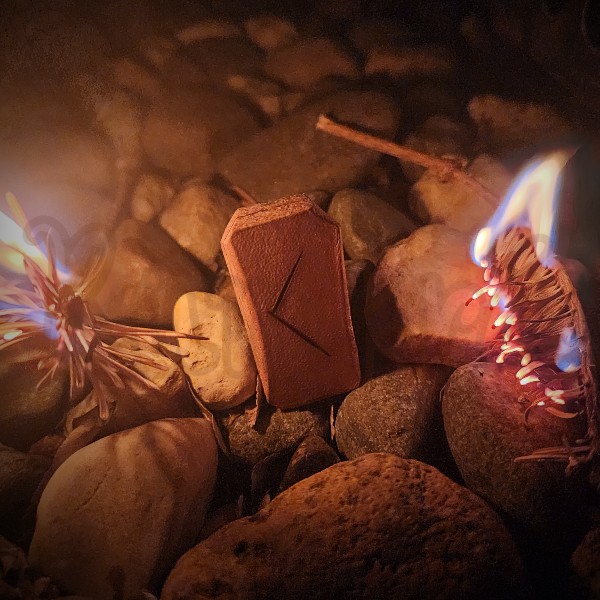
Rune Poems
✦ Old English Rune Poem
Definition: a torch is burning
alive like all living things.
Fire kept close,
shining sparkling,
where we shelter within.
✦ Old Icelandic and Latin
Kaun er barna bǫl, ok bardaga fǫr, holdfúa hús.
Kaun, hulcus: puer<orum> molestatio, prœlii vestigia, saniei
theca.
✦ Norwegian Rune Poem
Ulcer is fatal to children;
death makes a corpse pale.
✦ Icelandic Rune Poem
Kaun - Ulcer
Disease fatal to children
and painful spot
and abode of mortification.
Kenaz is the sixth letter of the Elder Futhark, transliterated as the K-rune. In Proto-Germanic it was called Kauną ("ulcer, boil"), just as it is described in the Norwegian rune-poem. In Anglo-Saxon, however, its name is Cēn ("pine torch"), forming the name Kenaz. There is the division: the Scandinavian tradition retains Kaunan "ulcer" while Anglo-Saxon prefers Cēn "torch. Perhaps this was a deliberate philosophical move to improve the feeling or association with the rune. The shape of Kenaz was likely formed from the Etruscan/Latin letter C, differing from the Anglo-Saxon ᚳ and Younger Futhark ᚴ variants, which could be seen as an incomplete K.
The Old English rune-poem for Kenaz is “Cēn is beorhtes lēohtes gesyhð, ðær hi Æþelingas binne restað,” translated as “The torch is known to every living man by its pale, bright flame; it always burns where princes sit within.” This creates the imagery of a great hall, lit not overwhelmingly but just enough by torches. It's not the fire that rages out of control: it is the spark of inspiration in the darkness, the light we bring to illuminate just enough our path to move forward. In the case of the OE rune-poem, the torches could be taken to represent an assembly of minds, each strengthening each other, in this case the wise minds and bright souls a leader has purposely gathered around himself.
The Norwegian and Icelandic versions are obviously quite different, focusing as they do upon affliction and the decay of flesh. In particular, it warns of a disease that an adult might endure but which is unendurable to children, the vulnerable members of a clan and its future. Kaun was interpreted as a harmful natural force, likening a deadly infection to a scourge, a whip of torture. If there is anything in common between the Old English and Norwegian interpretations, it's that they center on the duality of flame. One sees it for its illumination and life-giving fire, the other for the pain of inflamation or the burn of illness.
On the third hand, did not the Christians later seek enlightenment through the mortification of the flesh?
How the fire manifests in Kenaz is always small: the spark of inspiration, one's inner light, as much illumination as one requires to read a book or follow a path at night. This apparent weakness is intentional: the torch is a controlled fire, as opposed to a burning forest or a racing brushfire. It's the harnessing of a destructive element and focusing it for our benefit. Too much passion can consume us just as a disease or infection can, eating at our sanity, pushing our bodies to their physical extremes, using us up as the burning force propagates itself at the expense of its host. It wants to live and spread, just as all living things do, but what does it leave behind? It consumes and devours until nothing is left and it starves itself. But when isolated, when managed and contained, it's an invaluable source of energy. With it we can see in the darkness, we can transform the matter of meat and vegetables into something more digestible, and we can ward off the pain of cold.
Kenaz also represents one's inner light, and in this form we have to contemplate what we need in order to keep our personal fires alive. How do we feed it? How do we share it? Do we hide it from others because it's too bright? Are we afraid of scorching/blinding others, or simply of exposing ourselves to judgment? And how are we tending to our inner fires? What do we need, specifically, to return to robust health and the desire to create? How can we shine a light upon the shadows inside our corpore, find the sickness, burn out the infection? Kenaz is the torch that leads us down the road, whether the physical path or the trajectory of our development, but it's also the focused light by which we examine ourselves.
Keywords: Fire, Illumination, Passion, Ulcer, Suffering, Artistic Spark, Inner Change
Rune Reflections
- Where do I bring light into the lives of others? Where do I withhold it?
- What gifts or skills am I called to cultivate more consciously?
- Am I allowing passion to guide me or consume me?
- In what way is suffering itself a teacher or crucible for my growth?
- Where might I be misapplying my energy—burning too hot, too cold, or in the wrong direction?
- How can I honor the spark of inspiration when it appears?
- What do I bring to Kenaz? What do I offer it, from my own inner fire?